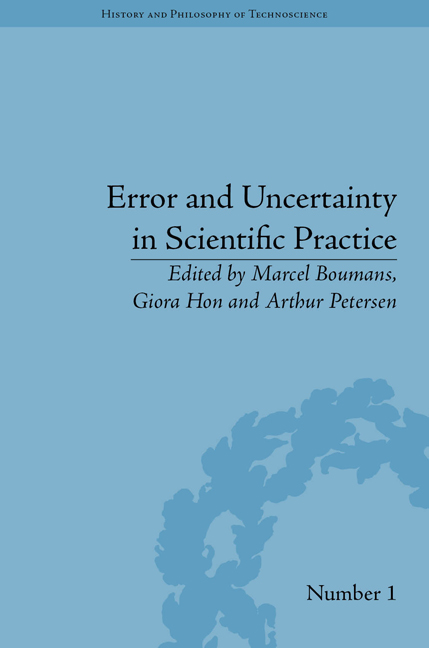Book contents
- Frontmatter
- Contents
- Acknowledgements
- List of Contributors
- List of Figures and Tables
- Introduction
- 1 The Lack of a Satisfactory Conceptualization of the Notion of Error in the Historiography of Science: Two Main Approaches and Shortcomings
- 2 Experimental Knowledge in the Face of Theoretical Error
- 3 Learning from Error: How Experiment Gets a Life (of its Own)
- 4 Modelling Measurement: Error and Uncertainty
- 5 Handling Uncertainty in Environmental Models at the Science–Policy–Society Interfaces
- 6 Variations on Reliability: Connecting Climate Predictions to Climate Policy
- 7 Order and Indeterminism: An Info-Gap Perspective
- 8 Learning from Data: The Role of Error in Statistical Modelling and Inference
- Notes
- Index
3 - Learning from Error: How Experiment Gets a Life (of its Own)
- Frontmatter
- Contents
- Acknowledgements
- List of Contributors
- List of Figures and Tables
- Introduction
- 1 The Lack of a Satisfactory Conceptualization of the Notion of Error in the Historiography of Science: Two Main Approaches and Shortcomings
- 2 Experimental Knowledge in the Face of Theoretical Error
- 3 Learning from Error: How Experiment Gets a Life (of its Own)
- 4 Modelling Measurement: Error and Uncertainty
- 5 Handling Uncertainty in Environmental Models at the Science–Policy–Society Interfaces
- 6 Variations on Reliability: Connecting Climate Predictions to Climate Policy
- 7 Order and Indeterminism: An Info-Gap Perspective
- 8 Learning from Data: The Role of Error in Statistical Modelling and Inference
- Notes
- Index
Summary
‘Experiment Lives a Life of its Own!’
This familiar slogan is often thought to capture the epistemic importance and power attributed to experiment. But decades after Hacking and others popularized it in philosophical circles, we are still in need of building a full-bodied philosophy of experiment.
• How should we understand this slogan?
• Where does the separate life of experiment take place?
• How does it manage to get a life of its own?
• Why should it want its own life?
Beginning with the first question, we may consider three interrelated glosses on the ‘own life’ slogan.
Experimental Aims: Apart from Theory Appraisal
The first sense in which experiment may be said to have its own life concerns experimental aims: to find things out quite apart from testing or appraising any theory. The goals are the local ones of obtaining, modelling and learning from experimental data: checking instruments, ruling out extraneous factors, getting accuracy estimates, distinguishing real effect from arte fact, signal from noise. Experiments are often directed at taking up the challenge of designing better experiments: how can we learn more, and do it faster? How can we more cleverly circumvent flaws and limitations?
To begin with, researchers wish to explore whether there is even something worth investigating. There may be no theory in place to flesh out, much less to test. The very domain in which any eventual theory might live may be unclear.
- Type
- Chapter
- Information
- Error and Uncertainty in Scientific Practice , pp. 57 - 78Publisher: Pickering & ChattoFirst published in: 2014



